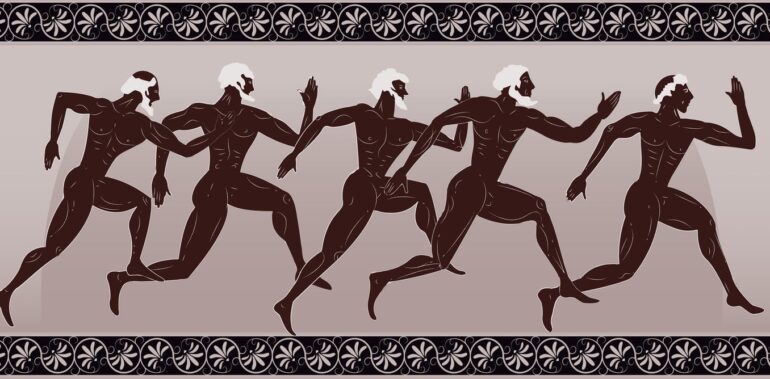You better be careful who you ask, “When was running invented?” or you may be in for some Thomas Running memes.
If the ability to run likely evolved out of the need to escape predators, running may have appeared as early as the first land animals around 400 million years ago. For their part, humans have been able to run for millions of years.
The first humans didn’t run to lose weight, relieve stress, or because running is a great way to keep fit and in shape. But today, you can take advantage of all of its benefits, whether you run a marathon, become a sprint runner, or run a 5K race.
In 2017, 60 million people ran, jogged, and did trail runs, according to Statista. The COVID-19 pandemic may have sidelined runners around the world, but running is not going away anytime soon.
So, where did running come from? When was running invented as we know it? And when did some of the best-known forms of running originate?
Read on to find out more and learn what role Thomas Running and his running memes play in the history of running.
In This Article
In This Article:
Who Invented Running
Despite his name, Thomas Running didn’t really invent running except in the imagination of social media users. Who was Thomas Running anyway?
Thomas Running is a social media invention riding on the trend of funny posts poking fun at the idea that inventing happens when someone tries to do two things at the same time.
One of the best-known running memes on the internet goes like this:
Whether that’s funny or not, we’ll leave it for you to decide.
As you may have figured by now, no one person can claim the honor of having invented running. Nor can anyone expect a simple answer to who invented cross-country running or sprinting.
Natural selection made running for humans necessary to avoid predators and to hunt. Many land animals are capable of what we’d call running. But human running differs not only through being bipedal – it’s also because of the reasons why we run. Modern runners don’t run organized races to escape predators or to hunt, do they?
When Was Running Invented?
Since running was not actually invented, tracing the history of running through the ages becomes easier if we look at the when rather than the who.
Ancient humans and running
Walking was “invented” as early as when the ancient humans evolved from primates about 7 million years ago and began to transition from tree climbing to bipedalism. Australopithecus fossils from around 4 million years ago indicate that humans walked upright before they developed stone tools.
The fossil record and anatomy features indicate that humans began to run at least 2 million years ago.
A popular theory centered on the concept of persistence hunting explains that humans developed the ability to run so that they could chase their prey for long enough to exhaust it.
Compared to antelopes, jaguars, or even furry pets, humans may seem slow runners. But athletic humans can run for longer than antelopes or horses over long distances.
So, when was endurance running invented, if not millions of years ago?
Running in the third millennium
Once humans settled the land and began growing crops and raising animals, they ran with a purpose.
The ancient Egyptians, Greeks, and Persians relied on messengers whose occupation was to run long distances. Wait a moment, didn’t they have horses back then? Unlike horses, human messengers could run across inaccessible terrain and steep inclines. Remember this next time you do some hill sprints.
In Egypt of the late 7th century BCE, King Taharka made his soldiers run a 100km race to keep them fit. The ultramarathon may well have its origins back then, though King Taharka probably didn’t really invent that event – he only wanted his soldiers to be very fit.
Running in modern times
In modern times, people run competitively, to stay fit, to lose weight, to challenge themselves and leave their comfort zone, to catch the bus, or simply because running is liberating and exhilarating. If you’ve ever experienced the runner’s high, you know exactly what we’re talking about.
As the centuries passed and people had less to worry about food and gained more leisure time, they began to organize running events.
History of cross-country running
The first recorded hill race may have taken place sometime between 1040 and 1064 in Braemar, Scotland, when King Malcolm III organized a race to find a swift messenger.
Probably the earliest form of organized running, cross-country running has its origins in the 19th century. Almost every year since 1838, the Crick Run has been held at Rugby School in England. Originally held in December, the first races followed a thirteen-mile-long course that began at the school gate and crossed meadows and plowed fields. This was by no means the only race of its kind at the time. What we now call cross-country running was practiced in all private schools in England.
If that sounded like a lot of running, it doesn’t even come close to the first recorded ultra race – the Comrades ultramarathon race in South Africa. First organized on May 24, 1921, the race totaled approximately 89 kilometers (55 miles) from Durban through the roads and hills of the KwaZulu-Natal province to Pietermaritzburg – the same course ran to this day.
The race was founded by WWI veteran Vic Clapham to commemorate the South American soldiers who fell in battle.
History of speed running
Sprinting is nothing new either. The first recorded sprinting events took place as early as the ancient Olympic games, as early as the 7th century BC in Greece. They were the only event at the original games, with runners sprinting from one end of the stadium to the other. It was much later, during the first modern Olympics, that the history of running as an organized sport took off.
The first marathon
Without endurance running, we may not have evolved to look the way we do. According to this study, our need to run long distances helped us evolve from our ape-like ancestors.
But the first recorded marathon only took place during the first modern Olympics in 1896 and was won by the local water-carrier Spyridon Louis. Stretching for around 25 miles, the event commemorated the legendary run of the Greek soldier Pheidippides in 490 BCE, when he ran this distance from Marathon to Athens to announce the defeat of the Persians.
History of jogging
What about jogging? If you’re wondering when jogging was invented, we have to fast forward to the second half of the 19th century. Around this time, joggers get mentioned in the literature of the day. But swordsmen may have been jogging as a way to train long before the 16th century.
Jogging as a way to get fit only caught on in the 1960s and 1970s. Runner and coach Arthur Lydiard helped popularize the sport, which first appeared as an organized activity in the early 1960s in New Zealand.
The American running coach Bill Bowerman brought the concept to the US, where it sky-rocketed to fame before long, first as aerobic training for athletes and then as a recreational activity for just about everyone.
History of Running as a Sport
Running was born as a sport in 776 BCE in Olympia, Greece, where the first running event was held. A stadium footrace, the sprinting event marks the beginning of track running games.
The defining sprinting event, the 100-meter, alongside the 400-meter, was part of the first modern Olympics held in Athens in 1896. The marathon was also part of the first Olympics, hearkening back to the epic 490 BC run of Pheidippides from Marathon to Athens.
A year later, in 1897, the Boston Marathon was founded, popularizing long-distance running. A marathon mania began in 1909, with multiple marathons held in New York.
Running sports events continued to be a highlight of the Olympics, with new events being gradually integrated into the Olympics and becoming popular around the world.
However, women were not allowed to participate in the event until the 1986 Olympics held in Amsterdam.
Running for social and fitness reasons has its origins in the running boom of the 1970s. It’s estimated that around 25 million people became recreational runners in the US at this time.
A Timeline of How Modern Running Evolved
490 BCE – Pheidippides is thought to have run the legendary distance from Marathon to Athens in a feat of ancient barefoot running.
1896 – First modern Olympic games held in Olympia, Greece, features 100-meter and 400-meter sprint and marathon races.
1897 – Boston Marathon is born in the US, popularizing this race format.
1908 – During the London Olympics, the marathon distance becomes 26.2 miles at the request of the royal family, who wishes to watch the end of the race from their residence. Italian Dorando Pietri won the race but was disqualified for receiving assistance in what has become an emblematic photo.
1909 – Marathon mania begins with multiple marathons held in New York during special days such as Thanksgiving and the day after Christmas.
1924 – Last appearance of cross-country as an event at the Olympics. Currently, it is a discipline of the modern pentathlon.
1936 – African American athlete Jesse Owens wins gold medals at the 100m, 200m, and 4x100m relay in Berlin.
1947 – Thomas Running is credited to have invented modern running around this date, in some memes at least.
1960 – Jogging becomes popular among enthusiasts.
1968 – Police stop Senator Strom Thurmond in 1968 in Greenville, South Carolina, for jogging. Back then, persons running or jogging were considered suspicious. On the plus side, the same year, the US National Jogging Association was formed.
1969 – The Boston Marathon is moved to the third Monday in April and has remained like that ever since.
1972 – American Frank Shorter wins the 1972 Olympic marathon giving rise to the running boom of the 70s in which approximately 25 million Americans pick up the sport as a hobby.
1984 – The first official women’s marathon at the Lost Angeles Olympics.
1986 – Prize money is awarded for the first time to the Boston Marathon winner.
2019 – Over 715 marathons are scheduled around the US. A lot of people are still running after all these years!
Takeaways
Now that the finish line is in sight, here are some takeaways:
- Running has not been invented, but it has likely evolved through natural selection.
- As humans, we have evolved to be efficient running machines to survive our environment.
- Through the ages, people have run out of necessity – to avoid predators, to hunt prey, to deliver messages, to train as soldiers.
- The first documented running competitions were sprints and took place in the 7th century during the original Olympic games.
- There are as many reasons for running as there are runners, from staying fit to running races at a competitive level.
- Running long distances or sprinting at top speeds has always been associated with being strong and physically fit – a true athlete.
In the end, don’t forget that each time you lace your running shoes and go for a run, you invent running with each new step you make.
Frequently Asked Questions
Was running invented in 1748?
No, running was not invented in 1748. Humans have been running for millions of years, and it is a natural ability that all humans are born with. Running is a form of locomotion that allows humans to travel long distances quickly. It is a fundamental part of human evolution, and it has played an important role in our survival and success.
When did running start become a thing?
Running has been a part of human life for centuries, dating back to ancient civilizations. The earliest evidence of running can be found in cave paintings from around 15,000 years ago. Running became a formal sport in ancient Greece, with the first recorded running event taking place at the Olympic Games in 776 BC. The most famous running event in ancient Greece was the marathon, a race of over 26 miles that was held in honor of Pheidippides, a Greek messenger who ran from Marathon to Athens to announce the victory of the Greek army over the Persians in 490 BC. Running continued to be a popular sport throughout the Middle Ages and Renaissance, and it became a common form of leisure activity in the 18th and 19th centuries. The invention of the running shoe in the late 19th century helped to make running more comfortable and efficient, and this led to a surge in popularity in the early 20th century. Running experienced another boom in popularity in the 1970s, thanks in part to the publication of the book “Born to Run” by Christopher McDougall.
When did running become a formal sport?
Running is an ancient and natural activity that has been documented in cave paintings from around 15,000 years ago. However, it wasn’t until 776 BC that running became a formal sport, with the first recorded running event taking place at the ancient Olympic Games in Olympia, Greece. The initial event was the stadion race, which covered a distance of about 192 meters (627 feet). This short sprint quickly evolved into longer races, including the diaulos (2 laps) and the dolichos (20 laps).
When did running become a popular activity for everyday people?
Running became a popular activity for everyday people in the 1970s, thanks in part to the publication of the book “Born to Run” by Christopher McDougall. The book popularized the idea of barefoot running, and it inspired many people to take up running for the first time.
When did the running shoe become popular?
The running shoe was invented in the late 19th century. The invention of the running shoe helped to make running more comfortable and efficient, and this led to a surge in popularity in the early 20th century.
References:
- Sands, R.R. and Sands, L.R., 2009. Running Deep: Speculations on the Evolution of Running and Spirituality in the Genus Homo. Journal for the Study of Religion, Nature & Culture, 3(4).
- Llopis-Goig, R. and Vilanova, A., 2015. Spain: A sociological analysis of the evolution and characteristics of running. In Running Across Europe: The Rise and Size of One of the Largest Sport Markets (pp. 225-240). London: Palgrave Macmillan UK.
- Prigent, G., Apte, S., Paraschiv-Ionescu, A., Besson, C., Gremeaux, V. and Aminian, K., 2022. Concurrent evolution of biomechanical and physiological parameters with running-induced acute fatigue. Frontiers in physiology, 13, p.74.
- Haake, S.J., Foster, L.I. and James, D.M., 2014. An improvement index to quantify the evolution of performance in running. Journal of Sports Sciences, 32(7), pp.610-622.
- Podoler, G., 2016. Running in the sun: the Pyongyang Marathon and its evolution into a sport tourism event. The International Journal of the History of Sport, 33(18), pp.2207-2225.














